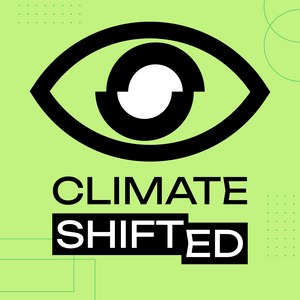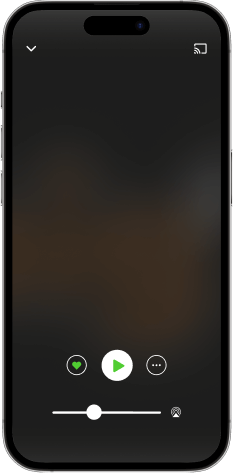When Data Dances: Matching Scientists with Artists for Stories That Connect with Neelambaree Prasad
In this episode of Climate Shifted, host Eva Frye speaks with Neelambaree Prasad, a pharmacologist and classical Indian dancer who refused to live a "split screen life." After becoming a mother during the pandemic and witnessing how climate change was the root cause of global health crises, Neelambaree co-founded ClimArts—a nonprofit that bridges the gap between climate scientists and artists to create stories that connect with both hearts and minds.
From ancient Indian temples that served as centers of learning through dance and music, to modern collaborations featuring ballet dancers personifying coral bleaching and comedians tackling air pollution, Neelambaree shows us why the future of climate communication isn't just better science or better art—it's the magic that happens when research meets emotional resonance.
Discover how to match scientific expertise with artistic expression, why "bounded imagination" keeps collaborations grounded, and the practical framework any organization can use to create climate stories that actually move audiences to action. Because when we combine data with dance, facts with feelings, we create something neither science nor art could achieve alone.
FULL TRANSCRIPT LIVES HERE.
Key Topics Covered
The Art-Science Gap in Climate Communication
Why technical climate messages push audiences away instead of drawing them in
How scientists and artists struggle to find meeting spaces for collaboration
The challenge of maintaining scientific accuracy while creating emotional connection
Moving beyond "doom and gloom" to solution-oriented storytelling
Ancient Wisdom for Modern Problems
How Indian temples historically served as centers of learning through art
The composite nature of classical Indian dance (music, theater, poetry, storytelling)
Applying traditional frameworks to contemporary climate challenges
The power of personification in connecting audiences to natural systems
ClimArts' Collaborative Framework
Building trust between scientists and artists through common goals
The concept of "bounded imagination" to maintain scientific integrity
Matching art forms to specific scientific messages and audiences
Managing the collaboration process from initial meeting to final product
Impact and Distribution Strategies
Creating docu-films for maximum reach and accessibility
Measuring both quantitative metrics and qualitative transformation stories
The "train the trainer" approach to amplifying impact through existing storytellers
Strategies for demonstrating value to funders in the arts-science space
Standout Quotes
"I always had this unrest in me about why my two worlds cannot converge."
"The pandemic had its root cause in climate change... And that's how ClimArts began."
"Science provides data and analysis and evidence while art accesses emotions and intuition, so together they create a more complete understanding of complex problems."
"It's not science alone that can do it. Not just policy that can do it, but there needs to be a cultural transformation, and that is where art comes in to change the narratives."
"We personified the river through our dance to convey that it's a sentient being."
"You cannot do it alone. That's the one big learning—you have to join forces... Collaboration, collaboration, collaboration is my learning."
"Who is this message for? No funder will accept the answer that my audience is the general public."
Featured Resources & Organizations
Neelambaree's Work:
ClimArts.org - Nonprofit connecting climate scientists with artists
ClimArts LinkedIn and Instagram
Neelambaree's LinkedIn
Resilient River - Dance piece about Indian rivers and flooding (featured on ClimArts website)
Key Collaborations & Partners:
Inside the Greenhouse, University of Colorado Boulder - Creative climate communication initiative led by Max Boykoff
Energy Change Institute at Oxford - Low carbon community transition theater project
English Youth Ballet - Coral bleaching ballet collaboration
Howard School of Public Health - Coral reef solutions partnership
Kings College London - Geography department (floods and droughts research)
School World Forum - Climate justice workshop venue
Key People Referenced:
Max Boykoff - Climate communications expert, author, and professor at CU Boulder; co-director of Inside the Greenhouse
Kripa Iyer - Co-founder of ClimArts, economist and dancer based in London
Dr. Daanish Mustafa - Kings College London geographer specializing in floods and droughts
Reports & Research Referenced
Climate Impact Studies:
Yale CBEY Net-Zero Report - References McKinsey climate analysis; notably focuses on land-based solutions with limited ocean emphasis
National Forests: Shifting Range - Forest migration patterns due to climate change
Scientific American: Greenland's Ice Sheet Collapse - Latest research on accelerating ice loss
Collaboration & Communication Frameworks:
Probable Futures: Bounded Imagination - Framework for keeping solutions grounded in what the science tells us
IDEO: Design Constraints - How limitations can enhance creative collaboration
Key Themes Explored
The Power of Personification
Making landscapes and natural systems feel like sentient beings
Drawing parallels between human experiences and environmental challenges
Moving beyond the trend to avoid anthropomorphizing nature
Rights of nature movements giving legal standing to ecosystems
Cultural Transformation Through Art
Why policy and science alone cannot drive necessary climate action
How art changes narratives and cultural understanding
The role of storytelling in making abstract concepts tangible and personal
Creating emotional openings that make audiences want to care and act
Collaborative Framework Design
Building trust through shared goals and clear role definition
Managing the tension between scientific accuracy and artistic expression
The importance of "bounded imagination" to maintain credibility
Intervening at key points to keep collaborations on track
Community-Centered Impact
Training existing storytellers rather than creating content for general audiences
Amplifying local voices and community-led solutions
Measuring transformation through both data and narrative
Creating sustainable funding models for arts-science collaborations
Juicy Bits: Key Takeaways for Climate Communicators
Know your specific audience - "General public" isn't an acceptable target. Create detailed personas including demographics, hopes, dreams, and challenges
Pick the right messenger - Ask yourself: Are you the most effective person to deliver this message? Should it be a subject matter expert or community voice instead?
Craft your message strategically - Once you know your audience and messenger, include: What's the problem? Why does it need solving? What's the proposed solution? End with hope or clear call to action
Embrace personification - Make natural systems feel like sentient beings to create emotional connection
Collaborate, don't work alone - The most impactful climate communication requires joining forces across disciplines
Use "bounded imagination" - Let artists think creatively while scientists ensure accuracy and nuance aren't lost
Create video content - Essential for reaching diverse audiences, especially post-pandemic
Focus on solutions - Move beyond doom and gloom to spotlight actionable pathways forward
Call to Action
Are you a scientist with a story burning inside, or an artist ready to ground your work in evidence? The climate crisis is too important for us to keep working in silos.
Support Neelambaree's Work:
Visit climarts.org to learn about collaboration opportunities
Follow @climarts_ on Instagram and LinkedIn for project updates
Apply to join their programs if you're an artist or expert
Consider philanthropic support—sponsors' names travel with films to festivals
Get Involved:
Share your favorite climate storytelling or art with @climateshifted on Instagram
Tell us why it moved you—we'll reshare our favorites
Consider becoming a paid substack subscriber for episode insight digests, and to help this volunteer-based team with a season 2!
Look for collaboration opportunities in your own community
Reach out to
[email protected] if you know of any grant or sponsorship opportunities that would be a good fit for us
Credits
Executive Producer & Host: Eva Frye
Technical Producer: Mateus Salgado
Audio Engineer: Gianna Scioletti
Project Management: Sarah Clayton
Social Media: Amanda Bauer, Ashley Chapman, Louise Lau


